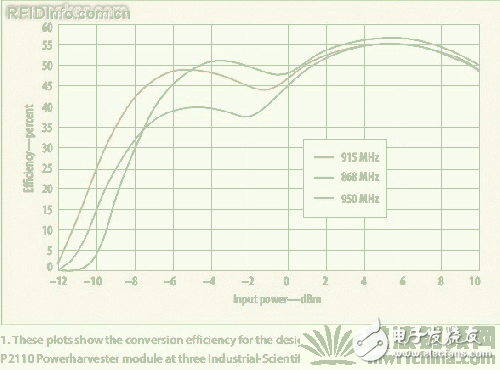Energy harvesting is a key technology for long-term maintenance-free operation of low-power electronic devices such as wireless sensors. By capturing excess energy in the environment, such as lighting, temperature differences, vibration, and radio waves (RF energy), low-power electronics can be fully operational. Among these micropower sources, the energy from the RF transmitter has unique advantages, including predictable and consistent power as a function of distance, allowing the energy harvester to stay away from energy constraints.
Environmental RF energy is now available from billions of wireless transmitters worldwide, including mobile phones, handheld radios, mobile base stations, and television/radio stations. The ability to capture this type of energy helps create new battery-free devices and allows battery-powered devices to be trickle-charged wirelessly. In addition to ambient RF energy, there is a way to use a dedicated transmitter to transmit power, which enables wireless power systems to provide higher performance. This is the preferred solution in many applications, but at a higher cost. Government regulations generally limit the radio output power of the unlicensed band to 4W effective isotropic radiated power (EIRP), just like a radio frequency tag (RFID) interrogator. In contrast, early mobile phones based on analog technology had a maximum transmit power of 3.6W, while Powercast's new TX91501 transmitter power was 3W.
Environmental radio frequency (RF) energy harvesting has a distinctly appealing point of collecting completely "free" energy. While devices with this capability can move while charging, many RF energy harvesting schemes require the use of directional antennas that point to known energy sources, such as mobile base stations. The application prospect in the field of mobile phones is to be able to collect enough ambient RF energy to match the standby power consumption of mobile phones. If possible, then the mobile phone will have continuous standby capabilities, not just a few days. While this particular application is currently not practical, the convergence of many system-level features is driving environmental RF energy harvesting solutions for other applications. These elements include the increasing popularity of low-power components, the availability of more transmitters as an energy source, the increased RF sensitivity of passive RF collectors, and the promotion of low equivalent series resistance (ESR) double-layer capacitors (also known as supercapacitors).
Manufacturers of low-power electronic components such as microcontrollers are sparing no effort to reduce component power consumption while improving performance. Data sheets and other marketing advertisements from these companies are interested in promoting several nanoampere-level standby currents and on-chip DC/DC converters that can boost from batteries with voltages less than 1V. Other components, such as sensors, are increasingly being designed as passive devices that help reduce overall system power consumption. This is especially important for batteryless devices. With sufficient real-time energy harvesting, battery-free equipment can operate continuously, but if the energy is too low, it must be stored until it is sufficient to maintain a duty cycle. Systems powered by energy harvesting techniques can work more frequently as component power levels decrease.
The number of radio transmitters, especially for mobile base stations and mobile phones, is increasing. According to ABI Research and iSupply, the number of mobile phone users has recently exceeded 5 billion, and the ITU estimates that more than 1 billion of them are mobile broadband users. There are also numerous Wi-Fi routers and wireless terminal devices such as laptops. In some urban environments, it is possible to detect hundreds of Wi-Fi access points. In a short range, such as in the same room, tiny energy can be collected from a typical Wi-Fi router with a transmit power of 50mW to 100mW. At longer distances, longer antennas with higher gains are needed to actually collect RF energy from mobile base stations and radio towers. In 2005, Powercast successfully demonstrated environmental energy harvesting at a distance of 1.5 miles (approximately 2.4 kilometers) from a small 5kW AM radio station.
Passive RF receivers or RF energy harvesting devices (such as Powercast's P2110 Powerharvester receiver) operate with an RF input level greater than or equal to -11dBm. Increasing RF sensitivity allows RF-to-DC (RF/DC) power conversion over a much longer distance from the RF energy source, but as distance increases, available power is reduced and charging time is extended. Energy storage technology with low leakage current is very important, especially when the input power is very low, so as to minimize the loss of energy collected and make the energy harvesting process as efficient as possible.
An important feature of RF energy harvesters is their ability to operate over a wide range of conditions, including changes in input power and output load resistance. For example, Powercast's RF energy harvesting components do not require additional energy-consuming circuitry for maximum power point tracking (MPPT), which is integral to other energy harvesting technologies that convert solar energy into electrical energy. Powercast components maintain high RF to DC conversion efficiency over a wide operating range, resulting in scalability across applications and OEM equipment. RF energy harvesting circuits that can accommodate multiple frequency bands or wideband frequency ranges and support automatic frequency tuning can further increase output power, thereby extending mobility and simplifying installation. Designed with a standard 50Ω input impedance, Powercast components not only help reduce design time, but also support the use of off-the-shelf antennas.

Figure 1 shows the performance of the Powercast P2110 Powerharvester receiver in multiple frequency bands, including the Industrial-Science-Medical (ISM) band with a center frequency of 915 MHz.
Shenzhen Ruidian Technology CO., Ltd , https://www.wisonen.com